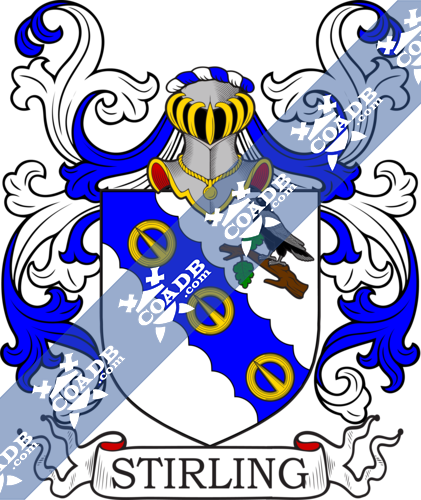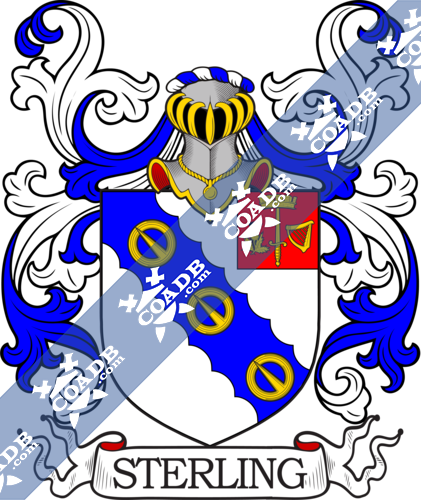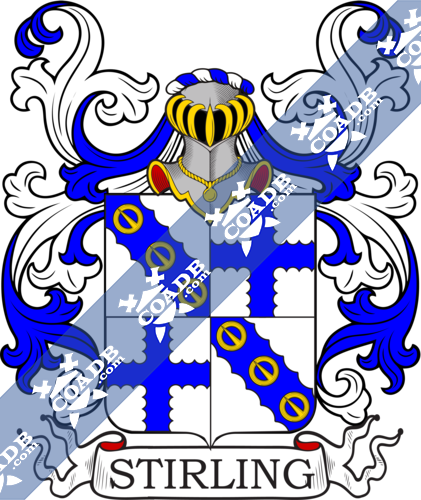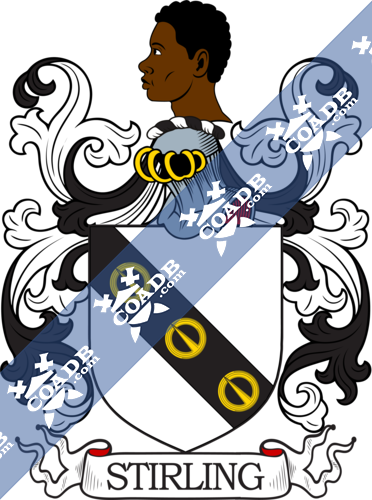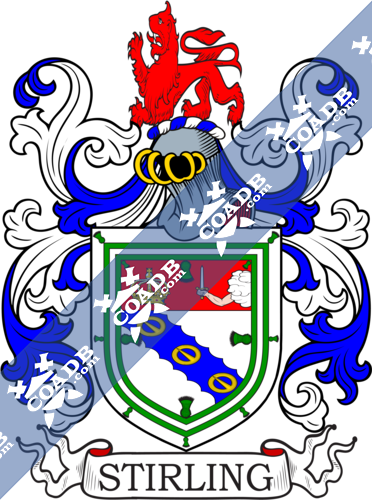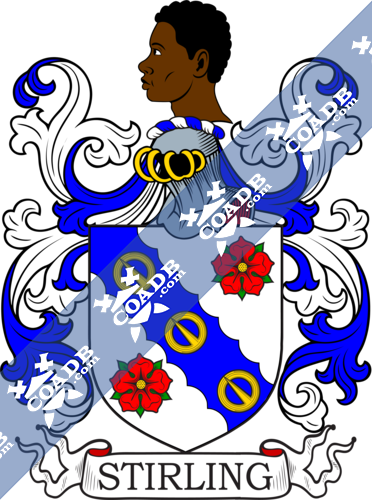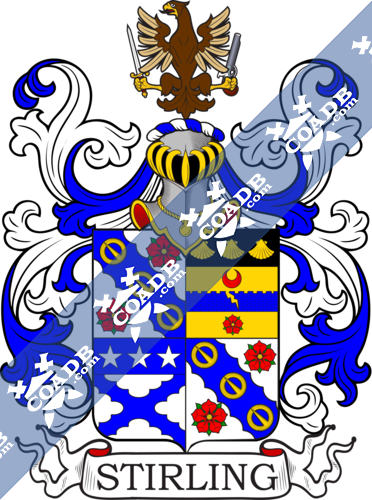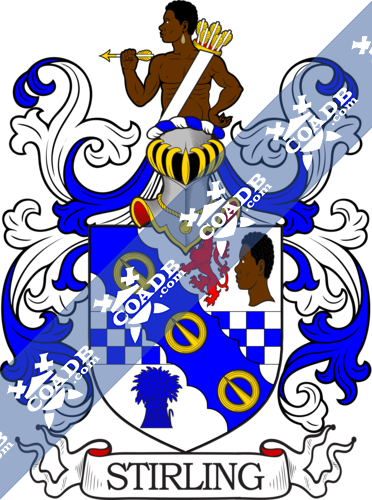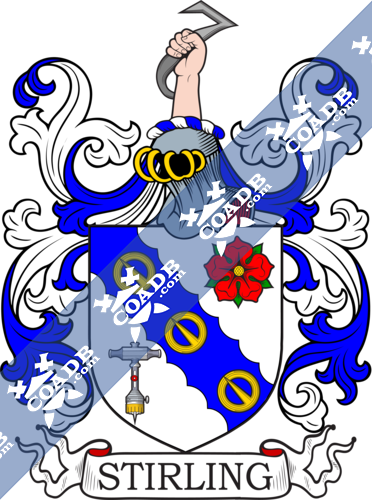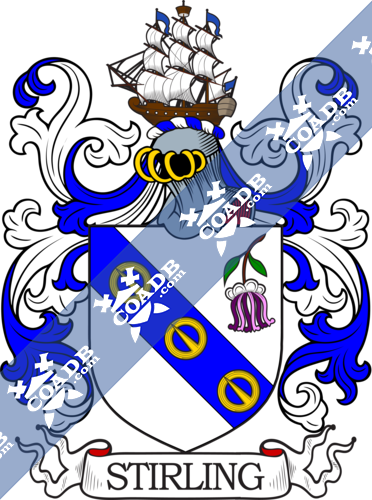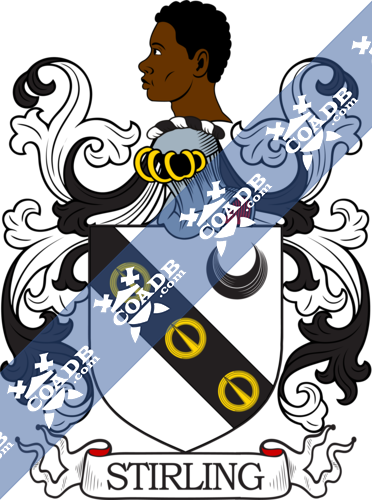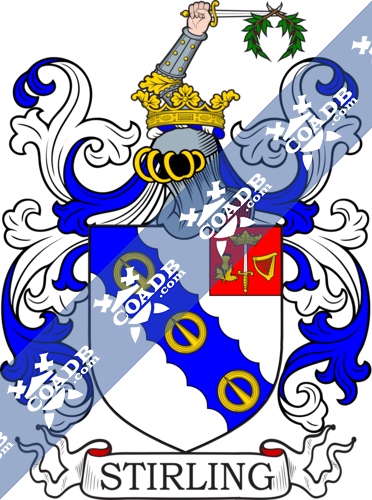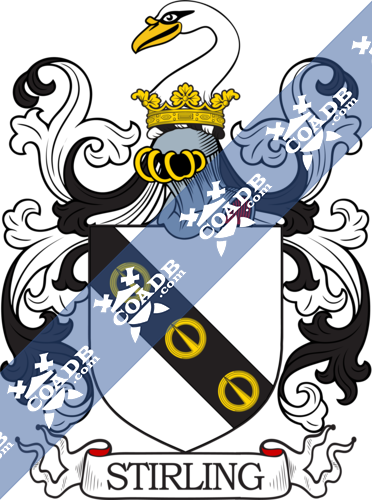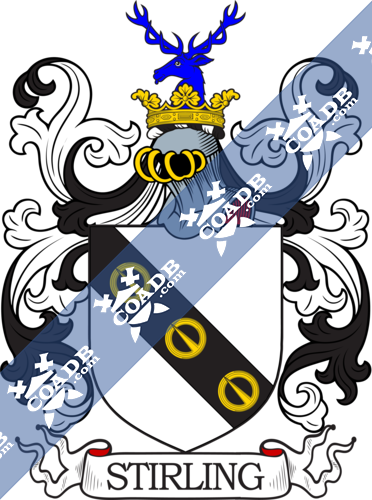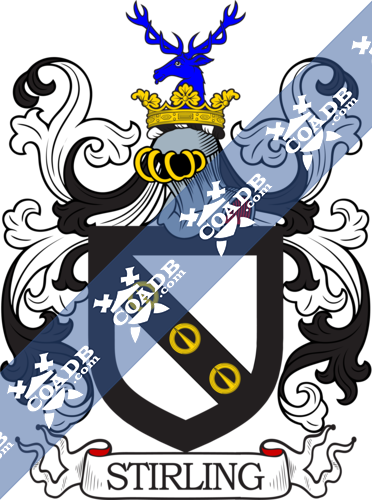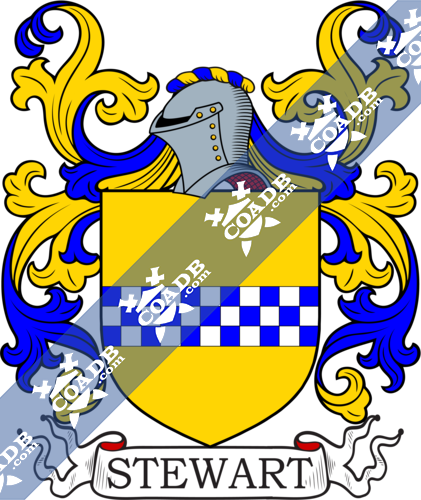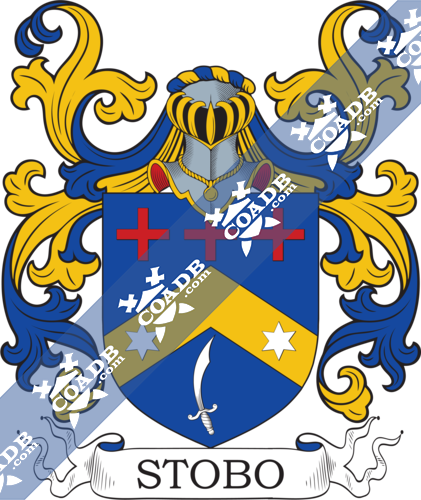Stirling Family Crest, Coat of Arms and Name History
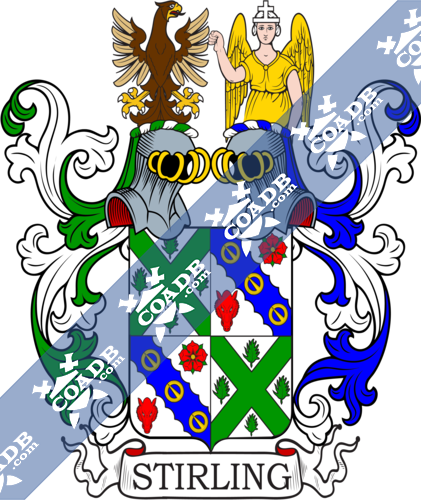
Stirling Coat of Arms Gallery
Don’t know which Coat of Arms is yours?
We can do a genealogical research. Find out the exact history of your family!
Learn MoreStirling
Stirling is one of the oldest names of Scotland. Translated into English from the evolved name, it means A Place of Strife. The name comes from the time when the Pictish people ruled over the southern half of Scotland, which then melded with an overlay from Norse invaders who were in turn supplanted by the Gaelic (Scottish) language The Scots Gaelic word Stirila, is the earliest version of the name. It is also the place-name of the Town of Stirling. The family name originally spelled Stryvelin, the founder of the family is widely accepted to be one Sir Walter de Stryvelin, who bore witness to King David I’s son Henry’s birth, in the 12th century. This is the first record of the family.
The Stirling family have been pivotal in the history of the kingdom of Scotland. The Battle of Bannockburn was fought within sight of Stirling Castle in 1314. This was a pivotal battle for Scottish independence. The English had occupied Stirling Castle, which sits atop a massif and has sheer vertical approaches on three sides, and it has historically controlled the lowest or southernmost crossing of the river Forth.
The English commander of Stirling Castle, while under a flag of parley, had agreed to surrender Stirling Castle to the Scottish forces of Robert the Bruce, if he and his garrison were not relived by the 24th of June 1314. On the 23rd of June the English under Edward II attempted to relieve the garrison, when they were attacked by a smaller force of Scottish Knights, and soldiers as they (The English) crossed Stirling bridge.
The English forces found themselves in marshy ground and were unable to deploy their mounted knights, nor were their archers effective, because English and Scottish forces had become intermingled. The battle of Bannockburn lasted for two days. At the end of the battle, Edward II and his army was severely beaten. Edward II fled the battle and attempted to seek shelter in Stirling castle only to be turned away by its commander, as he had given his word, to Edward Bruce, the brother of Robert the Bruce to hand over the castle to the Scottish forces. Bannockburn signaled the end of the first Scottish war for independence, and sowed the seeds for the second war of independence.
In 1333 an English army with Edward Balliol the Scottish claimant to the throne invaded Scotland with men who had, had their lands and titles stripped from them by the Bruce. Robert had died in 1329 and King David II was five years old. Sir John de Stryvelin the then heir of Clan Stirling fell at the battle of Halidon Hill. The battle was seen by the English as redemption of their martial prowess after the disastrous defeat at Bannockburn. Because Edward Balliol gave back all of the lands and titles to his followers they had lost, it spawned a third war for independence. King David II had been in exile in France came back as a young man, who rallied those loyal to his family, and was able to defeat Balliol. The Stirling family helped in his efforts to retake the throne.
After the third war for Scottish independence ended, a flowering of the Stirling family happened; because of their prominence in political and military affairs of the time, what was to become Clan Stirling (lowland family) rose in ascendancy. At one time they were appointed as the Royal Seneschals (person in charge of a manor or castle.) for castle Dunbarton, traditional home of Clan Fraser, and the county of Dunbartonshire they were appointed as Sheriff, ( A Sheriff is an official appointment in the medieval era which combined judicial services, writs and orders, security services, and the collection of taxes for an entire region. It was considered a very high appointment, and carried a great deal of responsibility.)
There have been four Baronetcies created for the Stirling family, all but one are now extinct; meaning there was not a living heir to leave the title to. One is dormant, which means the family has not applied for or has not undergone a review for the title to be considered extant or alive. The four baronetcies are in order of creation, Baronet of Ardnoch, created in 1651 (extinct 1808), Baronet of Stirlingshire created in 1666 (dormant,) Baronet of Mansfield, Aryeshire created in 1792 (extinct 1843,) Baronet of Faskine, Lanarkshire created in 1800 (extinct 1934)
Clan Stirling’s Motto is “Gang Forward or Go Forward”
Royalty associated with Clan Stirling:
The family has served every Scottish monarch from Bruce except Balliol, to the time of the Unification of Scotland and England under King James VI who had inherited both the Scottish and English crown. The English throne came by way of James VI being the closest male heir to his cousin Queen Elizabeth II.
Notable members of Clan Stirling:
Clan Stirling has produced four Admirals, Three Generals, the founder of the Special Air Service, Three Ambassadors, half a dozen politicians, several internationally known lawyers, multiple scientists/inventors (Stirling Engine,) musicians, entertainers, writers, sports figures. Stirling’s can be found in Scotland, Canada, Australia, New Zealand, Jamaica, South Africa, and the United States of America.
Places associate with Clan Stirling:
Stirling Castle, Stirlingshire, Edinburgh Castle, Dunbarton Castle, Dunbartonshire, Fief, Kier, Kier House, Glorat, Glorat House, Commonwealth of Jamaica, Lanarkshire, Drum, Edinburgh, Glasgow, House of Lords, Parliament, London, University of Sterling, University of Edinburgh
Blazons & Genealogy Notes
1) (co. Suffolk). Az. a cross formée betw. four estoiles or.
2) Az. a cross flory (another, pattée) betw. four estoiles or.
3) Az. two bars gemel ar. on a chief of the second three lozenges gu.
4) (Fun. Ent. Ulster’s Office, 1661, Sir Robert Sterling, Knt.). Ar. on a bend engr. az. three round buckles or, on a sinister canton gu. a sword erect in pale, the point pierced through a mural crown betw. on the dexter a thistle, and on the sinister a harp, all of the third.
5) (Keir, co. Perth). Motto—Gang forward. See Maxwell., of Pollok, bart. Ar. on a bend sa. (another, az.; another, engr. vert) three buckles or. Crest—A Moor’s head couped ppr.
6) (Kippendavie, Scotland). Motto—Gang forward. Ar. on a bend sa. three buckles of the first, in chief a crescent of the second. Crest—A negro’s head ppr.
7) (Bankell, co. Stirling). Motto—Fides servata secundat. Ar. on a bend engr. az. three buckles or, in chief a lion’s head erased gu. Crest—A lion pass. ppr.
8) (Ardoch, Scotland, bart., 1666; represented by Home-Drummond, of Blair Drummond, as heir of line). Ar. on a bend engr. az. three buckles or, quartered with Ar. a cross engr. az., for Sinclair.
9) (Cadder, co. Stirling; direct line ended in an heiress in the 16th century). Ar. on a bend sa. three buckles or. Crest—A swan’s head and neck issuing out of a ducal coronet ppr.
10) (Drumpellier, co. Lanark, 1818). Same Arms. Creat—Issuing out of a ducal coronet a hart’s head az. Supporters—Two Caledonian bulls ppr. gorged and chained or. Mottoes—Gang forward; and, Caatrum et nemus Strevileuse.
11) (Glasgow, 1870). Motto—Gang forward. Same Arms, within a bordure sa. Same Crest.
12) (Faskine, co. Lanark, bart., 1800). Motto—Gang forward. Ar. on a bend engr. az. betw. two roses gu. seeded or, barbed vert, three buckles of the fourth, all within a bordure of the fifth. Crest—A dexter arm armed, issuing out of a ducal coronet, grasping a dagger in fesa all ppr. the last hilted and pommelled or. Supporters—Two hinds purp. semée of estoiles ar. ducally gorged or.
13) (Craigbarnet, co. Dumbarton). Ar. on a bend engr. az. betw. a rose in chief and a boar’s head cabossed in base gu. three buckles or. Crest—A lady issuant from the breast upwards ppr. robed and winged or, ensigned on the head with a cross ar.
14) (Garthshore-Stirling of Craigbarnet). Motto—I renew my age. Quarterly, 1st and 4th, ar. a saltire cantoned with four hollyleaves slipped vert, for Garthshore; 2nd and 3rd, Stirling, of Craigbarnet, as above. Crest, for Garthshore—An eagle displ. ppr. Supporters—Two eagles with wings expanded ppr.
15) (Glorat, co. Stirling, bart., 1866; now heir male of Craigbarnet). Motto—Semper fidelis. Ar. on a bend engr. az. three buckles or, on a chief gu. in the dexter canton an imperial crown, in the sinister a naked arm issuing out of a cloud and grasping a sword in pale all ppr. the whole within a double tressure flory counterflory of thistles vert. Crest—A lion pass. gu.
16) (cadet of Glorat, 1672). Or, on a bend engr. betw. a rose in chief and a martlet in base gu. three buckles of the field.
17) (Law. co. Dumbarton). Motto—Hic fides et robur. Ar. on a bend engr. az. three buckles or, in chief on a branch of oak a raven ppr.
18) (Herbertshire, co. Stirling, 1672). Motto—Gang forward. Ar. on a bend engr. az. betw. two roses, one in chief and the other in base gu. three buckles or. Crest—A Moor’s head couped ppr.
19) (Graham-Stirling, of Duchray). Mottoes—Over: For right; and, below the arms: Noctesque diesque præsto. Quarterly, 1st and 4th, ar. on a bend engr. az. betw. two roses gu. three buckles or; 2nd, or, a broken wall az. betw. a crescent in the collar point and in base a rose gu. on a chief engr. sa. three escallops of the field; 3rd, ar. a saltire engr. az. on a chief of the last three mullets of the field. Crest—An eagle displ. holding in the dexter claw a sword, and in the sinister a pistol ppr. Supporters—Two lions ar. imperially crowned or.
20) (Mansfield, co. Ayr, bart., 1792). Motto—Forward. Ar. a fess chequy az. and of the field betw. a lion ramp. gu. and a Moor’s head couped ppr. in chief and a garb of the second in base, over all a bend engr. also of the second, charged with three buckles or. Crest—A demi Moor, on his back a sheaf of arrows, his dexter arm stretched out, holding an arrow in fess all ppr. Supporters—Two Moors, girt round the loins with belts of feathers, each having a fillet wreathed ar. and az. round his head, a quiver of arrows at his back, a sword at his side, sandals on his feet, and resting with his exterior hand on a bow all ppr.
21) (Larbert. co. Stirling, 1864). Same Arms, Crest, and Motto, but without the Supporters.
22) (George Stirling, Chirurgeon in Edinburgh, 1672). Motto—By wounding I cure. Ar. on a bend engr. az. betw. a rose in chief gu. and a trepan (a chirurgical instrument) in base ppr. three buckles or. Crest—A dexter hand poiating a lancet ppr.
23) (Dundee, Scotland, 1672). Motto—Faveutibus auris. Or, on a bend az. three buckles of the first, on a chief a columbine flower slipped ppr. Crest—A ship under sail ppr.
24) (confirmed by Roberts, Ulster, 1649, to Sir Robert Stiriling, Knt., Governor of the city and county of Cork, fourth son of William Stiriling, Esq., of Glorate, in the Sheriffdom of Lenox, in Scotland, who was son of William Stiriling, Baron of Glorate). Motto—Gang through. Ar. on a bend engr. az. three buckles or, and for augmentation, on a canton gu. a sword in pale supporting on the point a crown all ppr. betw. a thistle and harp of the third. Crest—Out of a ducal coronet or, an armed arm holding in the hand a sword, the point supporting a crown of laurel sill ppr.


